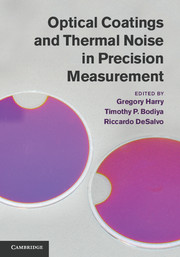Book contents
- Frontmatter
- Contents
- List of contributors
- Foreword
- Preface
- 1 Theory of thermal noise in optical mirrors
- 2 Coating technology
- 3 Compendium of thermal noises in optical mirrors
- 4 Coating thermal noise
- 5 Direct measurements of coating thermal noise
- 6 Methods of improving thermal noise
- 7 Substrate thermal noise
- 8 Cryogenics
- 9 Thermo-optic noise
- 10 Absorption and thermal issues
- 11 Optical scatter
- 12 Reflectivity and thickness optimization
- 13 Beam shaping
- 14 Gravitational wave detection
- 15 High-precision laser stabilization via optical cavities
- 16 Quantum optomechanics
- 17 Cavity quantum electrodynamics
- References
15 - High-precision laser stabilization via optical cavities
Published online by Cambridge University Press: 05 January 2012
- Frontmatter
- Contents
- List of contributors
- Foreword
- Preface
- 1 Theory of thermal noise in optical mirrors
- 2 Coating technology
- 3 Compendium of thermal noises in optical mirrors
- 4 Coating thermal noise
- 5 Direct measurements of coating thermal noise
- 6 Methods of improving thermal noise
- 7 Substrate thermal noise
- 8 Cryogenics
- 9 Thermo-optic noise
- 10 Absorption and thermal issues
- 11 Optical scatter
- 12 Reflectivity and thickness optimization
- 13 Beam shaping
- 14 Gravitational wave detection
- 15 High-precision laser stabilization via optical cavities
- 16 Quantum optomechanics
- 17 Cavity quantum electrodynamics
- References
Summary
Introduction
Optical cavities are extremely useful devices in laser-based research. Within the context of precision measurement, they enable tests of the laws that govern the macroscopic structure of the universe, embodied in the search for gravitational waves (Abbott and The LIGO Scientific Collaboration, 2009) (see also Chapter 14). At the other end of the length scale, cavity-stabilized lasers are powerful tools for precision spectroscopy that probe nature at the quantum mechanical level, through tests of quantum electrodynamics (QED) (Kolachevsky et al., 2009). Furthermore, cavities enable high-sensitivity broadband spectroscopy (Thorpe et al., 2006), which has practical applications in trace gas sensing; exploration of new light – matter interaction regimes in cavity QED (Miller et al., 2005) (see also Chapter 17); tests of fundamental physical principles including relativity (Brillet and Hall, 1979; Hils and Hall, 1990; Eisele et al., 2009), local position invariance (Blatt et al., 2008), and the time invariance of the fundamental constants of nature (Fortier et al., 2007b); and nonlinear optics, including coherent light build-up for studies of extremely nonlinear effects (Gohle et al., 2005; Yost et al., 2009). In general, optical cavities have become indispensable tools at the heart of many modern experiments.
In conjunction with optical frequency combs, cavity-stabilized laser systems have enabled the development of highly accurate frequency standards based on neutral atoms (Sterr et al., 2004; Takamoto et al., 2005; Ludlow et al., 2006; Le Targat et al., 2006; Ludlow et al., 2008; Lemke et al., 2009) and trapped ions (Diddams et al., 2001; Madej et al., 2004; Margolis et al., 2004; Rosenband et al., 2008).
- Type
- Chapter
- Information
- Optical Coatings and Thermal Noise in Precision Measurement , pp. 237 - 258Publisher: Cambridge University PressPrint publication year: 2012
- 4
- Cited by



